Master Plants - Onanyati
Master Plants - Onanyati
Master Plants
The Shipibo people are known for their rich tradition of plant medicine and shamanism. In Shipibo culture, the term "Onanyati," refers to specific plants revered for their potent healing properties and spiritual significance. These plants are considered allies and guides in the Shipibo shamanic tradition, facilitating deep insights, healing, and transformation for individuals seeking spiritual growth and healing.
The Shipibo people believe that master plants possess an inherent intelligence and consciousness that can communicate with humans on a profound level. Through the traditional practice of ayahuasca ceremonies and plant diets, Shipibo shamans and apprentices engage with these master plants to receive guidance, healing, and teachings. The relationship between the Shipibo people and master plants is characterized by respect, reciprocity, and a deep understanding of the interconnectedness of all life forms in the rainforest ecosystem.
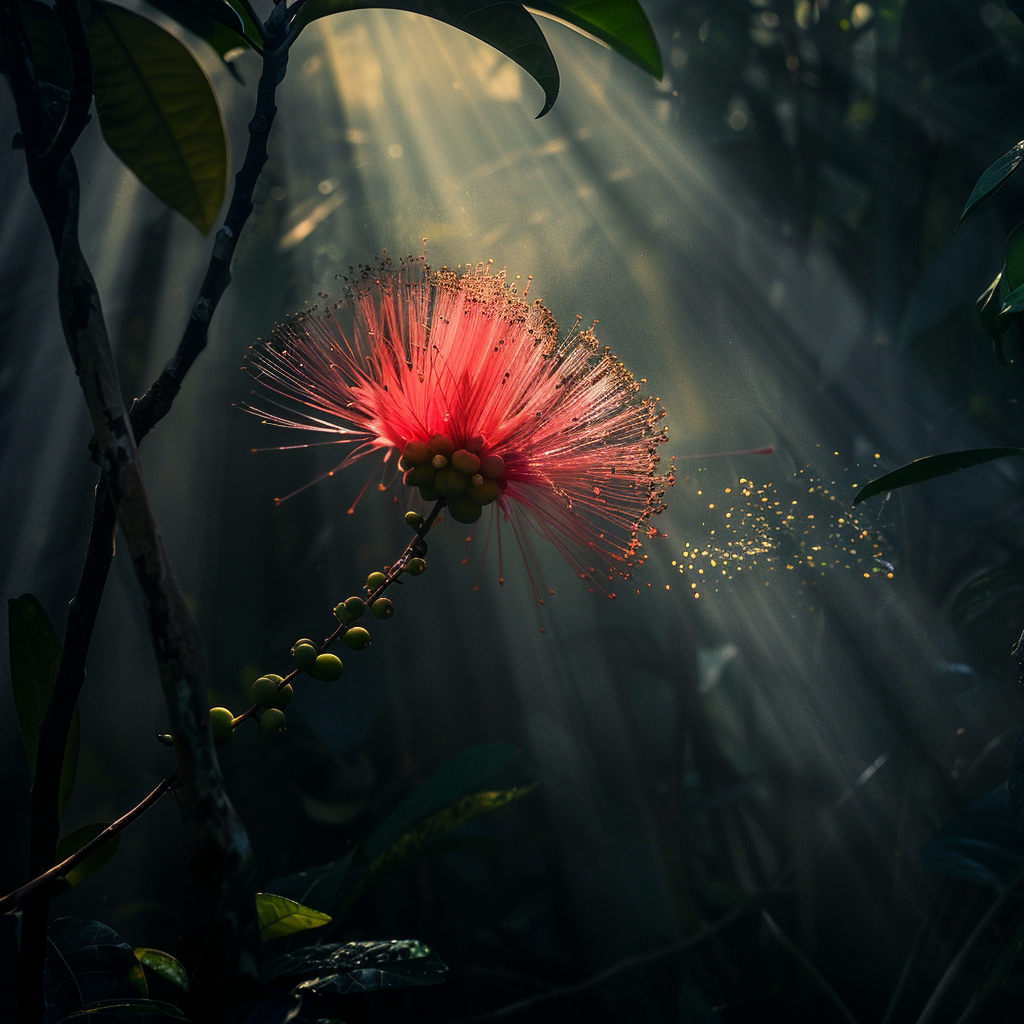
Bobinsana
Bobinsana, scientifically known as Calliandra angustifolia, boasts a multitude of common names, including balata, bubinianal, capabo, newei, and semein, each reflective of its diverse presence across the Amazon region.
Embracing Nature’s Healer
Thriving in water-rich environments and reaching heights of up to 6 meters, Bobinsana serves as a potent source of MAO-inhibitors and COX-inhibitors. Traditionally administered as tinctures, extracts, or tea infusions, this revered herb is often recommended by shamans for alleviating arthritis, rheumatism, and chronic musculoskeletal pains. Beyond its physical healing properties, Bobinsana infuses a heart-centered tranquility into one’s being, fostering introspection and allowing roots to stretch and connect with the Earth.
A Splendor of the Amazon
Akin to its cousin, the mimosa tree, Bobinsana flourishes along water bodies such as rivers and streams, adorning its lush foliage with radiant anemone-like flowers that blush red-pink during the gentle morning and twilight hours. Revered by the Shipibo indigenous communities along the Ucayali river, where transformative retreats unfold, this botanical marvel is affectionately known as semein. Its medicinal versatility is matched only by its spiritual essence, offering holistic wellness and profound insights.
Harnessing the Healing Potential
Various parts of the Bobinsana plant are meticulously prepared to address specific health concerns. The bark, revered for its therapeutic potency, is meticulously extracted and boiled to combat rheumatism, stimulate the nervous system, and even serve as a contraceptive. Similarly, the roots undergo a rigorous extraction process to cleanse the blood and address uterine disorders, while the entire plant, encompassing leaves, stems, bark, roots, and flowers, is brewed to invigorate the body and mind.
Bobinsana Health Benefits
- Anti-inflammatory
- Anti-arthritic
- Anti-rheumatic
- Tonic
- Depurative
- Stimulant
- Anticancerous
- Contraceptive
- Diuretic
Embracing the Goddess of the Amazon
The Shipibo people attribute Bobinsana with a profound affinity for beauty and the arts, igniting the creative spark within individuals and facilitating self-expression. As a guiding muse, she empowers vocalization and fosters communion with plant spirits to receive celestial melodies. Bobinsana envelops seekers in a cocoon of love and tenderness, guiding them along the path of beauty and grace. With her gentle embrace, she unfurls the petals of the heart, fostering spiritual growth and illuminating the sacred connection to nature.
Spiritual Significance:
Bobinsana, with its innate capacity for spiritual expansion and heart awakening, serves as a conduit for profound surrender and communion with nature. Engaging with this sacred plant spirit offers solace to those grappling with heartache or grief, providing a sanctuary for the release of stored trauma and emotional burdens. Through its transformative embrace, Bobinsana unveils the path to spiritual liberation and inner harmony.
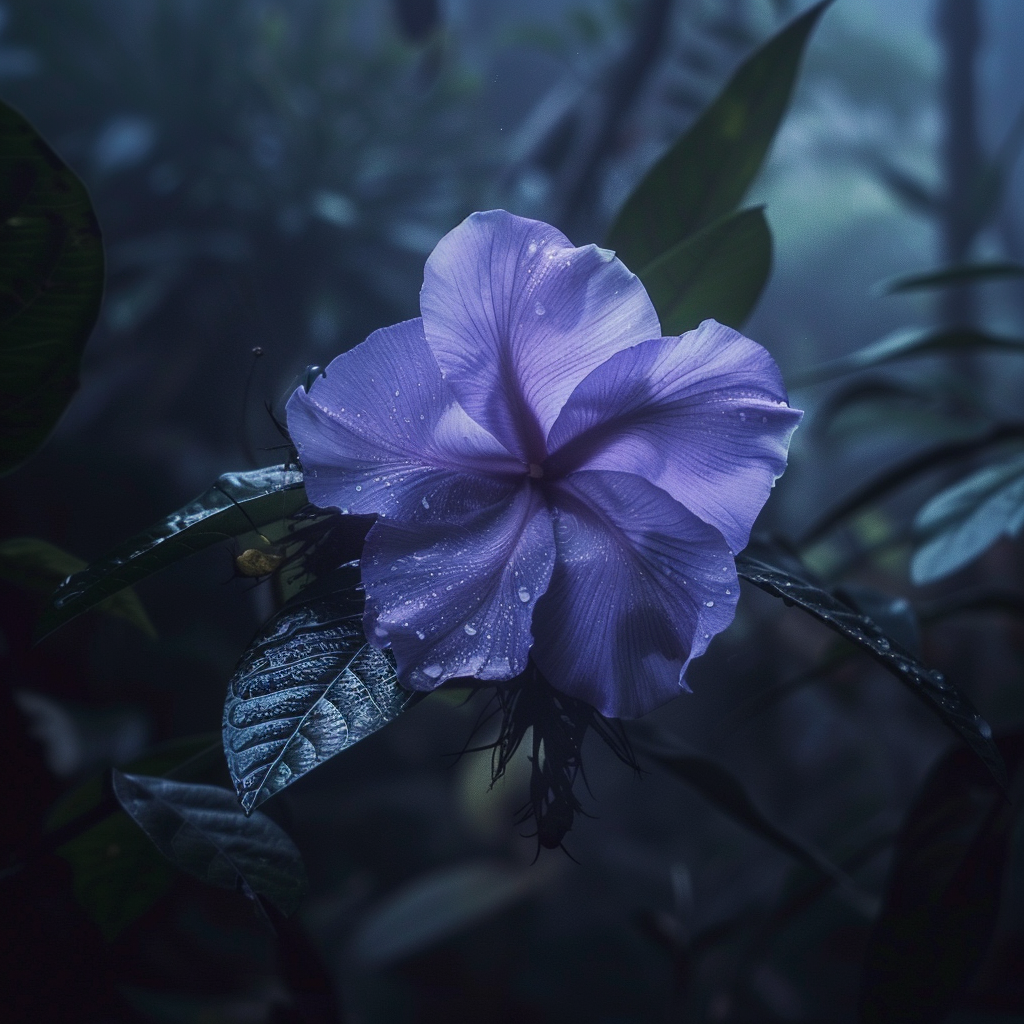
Chiric Sanango
Chiric Sanango, or Brunfelsia grandiflora, is a captivating Amazonian shrub adorned with striking purple and white blossoms. Reaching a height of approximately 8 to 10 feet, it boasts a splendid floral exhibition. This evergreen shrub features simple, oblong-shaped green leaves amidst its foliage. Characterized by its moderate growth rate and upright stature, it thrives in the lush jungle environment. The flowers emit a delightful fragrance, showcasing their beauty best during the summer months, although they can also flourish during spring and fall in various climates. Sporting brown stems of medium thickness, this resilient shrub demonstrates remarkable resistance to pests and diseases, making it adaptable to a range of soil conditions.
Exploring the Essence of Chiric Sanango
Chiric Sanango, a revered member of the nightshade family, flourishes abundantly throughout South America. In the native Peruvian language of the Amazon, Quechua, “Chiric” translates as “itchy” or “tickling,” symbolizing the prickly sensation experienced upon ingesting its brew. This physical effect, along with its memorable medicinal properties, underscores Chiric Sanango’s significance in both traditional Amazonian practices and modern healing rituals.
Medicinal and Spiritual Insights
Chiric’s distinctive medicinal attributes extend to its ability to balance serotonin levels, offering solace to those grappling with profound grief, depression, or anxiety. It serves as a beacon of hope for individuals feeling disconnected from themselves or others, navigating deep-seated insecurities, or entangled in ego-driven patterns. Through its heart-opening and invigorating energy, Chiric Sanango fosters a profound sense of unity with the earth and all living beings, unveiling the universal love that binds us together.
Shamanic Reverence
In the rich tapestry of Peruvian shamanic traditions, Chiric Sanango assumes the esteemed role of the male counterpart to Ayahuasca, often regarded as grandfather or father. Its medicinal prowess encompasses treatments for flu, colds, venereal diseases, chronic pain, arthritis, and rheumatism. During retreats guided by revered shamans like Maestra Matilde, Chiric’s leaves offer respite to those battling arthritis and rheumatism, imparting healing and relief.
Journeying to Spiritual Realms
To unlock the spiritual essence of Chiric Sanango, practitioners prepare a tea-like decoction from its leaves, bark, and roots, adhering to the regimen outlined by the maestro curandero. The process often initiates intense physical effects, including dizziness, disorientation, itchiness, chills, fatigue, weakness, nausea, and vomiting. However, these challenges serve as gateways to profound spiritual metamorphosis, leading to a transcendent sense of relief and tranquility.
Embracing the Physical and Spiritual
While the physical effects may dissipate by the third day, their integration into the spiritual journey is indispensable. Beyond discomfort lies a realm of spiritual growth and enlightenment, paving the way for transformative rewards. Through disciplined practice and dedication, Chiric Sanango unveils a myriad of benefits, enriching both body and soul.
Physical Benefits
- Nurtures the nervous system
- Strengthens bones and treats bone diseases
- Enhances vitality, especially for elders
- Boosts libido and addresses impotence
- Radiates warmth to body and heart
- Alleviates arthritis and regulates blood pressure
- Exhibits potent anti-inflammatory properties
- Offers relief from asthma and bronchial disorders
- Sharpens cognitive function and mental clarity
Spiritual significance:
In the realm of spiritual growth, the grandfather Chiric Sanango plant teacher bestows upon the committed dietero an array of profound effects. These include vivid dreaming, accompanied by intense emotional release intertwined with a deep sense of awareness and gratitude for the emotions being liberated. Moreover, one experiences heightened mental clarity, a surge in confidence and self-esteem, and a profound appreciation for the interconnectedness of all life.
For those seeking to fortify their willpower, enhance decision-making capabilities, and embrace a more courageous and heart-led existence, the brunfelsia grandiflora beckons. This resplendent purple shrub possesses the remarkable ability to navigate through energetic blockages harbored within, allowing them to dissolve. However, it is imperative to approach its usage with meticulous mental and physical preparation. When wielded with dedication, this plant offers the promise of profoundly clarifying visions, guiding the earnest seeker towards absolute clarity.
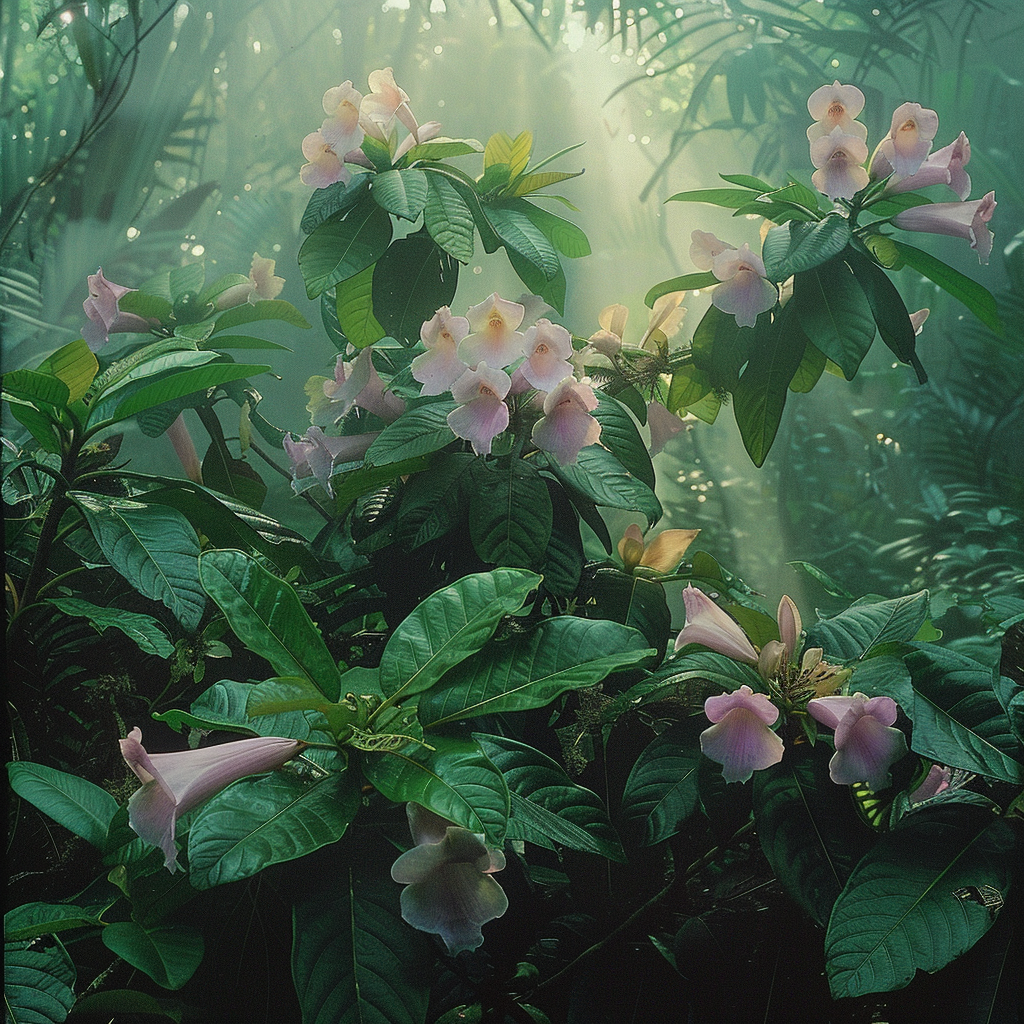
Ajo Sacha
Ajo Sacha, also recognized as Manso Alliacea, is a tropical vine indigenous to Northern South America, thriving in the upper Amazon rainforest. Among the mestizos, it earns the monikers “wild garlic” or forest garlic. “Ajo” translates to “garlic,” while “Sacha” denotes “wild.”. Ajo Sacha has a rich history of medicinal use among the native communities. Renowned for its garlic-like aroma, this plant is employed by jungle inhabitants who attribute to it the power of healing both physical and psychological ailments, including the strengthening of self-esteem and will.
Cleansing Benefits
The shrub, known for its cleansing properties, holds a sacred place in the traditions of native indigenous tribes. Revered for its ability to purify the digestive system and inner energetic tracks, it is utilized with deep respect to chase away evil spirits. A dieta with Ajo Sacha prior to an Ayahuasca retreat is believed to facilitate the body’s reception of the mother vine and aid in the distribution of energy through the physical body, enabling endurance during intense plant dietas.
Strengthening and Healing Properties
With remarkable strengthening properties, Manso Alliacea is often recommended during periods of intense life changes. This shrubby vine, utilized for generations across Amazonian communities, is known to cleanse the body and alleviate ailments such as fevers, colds, and headaches. Its efficacy has been validated through extensive laboratory studies, reaffirming its significance in traditional medicine.
Versatile Utilization
Every part of the bush finds purpose in various traditions and medicines. Stems and leaves are applied externally to soothe muscular pains or inflammations, while a tincture from the root serves as a regenerative tonic. Tea brewed from scraped roots aids in female fertility, and a soothing bath with leaves combats flu symptoms or cramps. Crushed leaves applied to the forehead offer relief from headaches.
Diverse Names and Recognition
The shrub, widely recognized for its healing properties, goes by numerous names, including Adenocalymma alliaceum, Bignonia alliacea, and garlic vine, among others. Despite its associations with garlic in scent and name, it stands as a unique entity in botanical classification.
Mood Enhancement and Spiritual Influence
Manso Alliacea possesses remarkable gifts, banishing negative energies and enhancing mood and personal strength. Floral baths with its leaves are a common practice, while its impact on dreams is notable, leading to deeper, more vivid experiences and heightened lucidity.
In conclusion, the shrub, with its multifaceted benefits and spiritual influence, continues to enrich the lives of those who embrace its healing properties and deep-rooted significance.
Additional Medicinal Properties:
- Analgesic – Helps relieve pain
- Anodyne – Helps reduce pain
- Antioxidant – Prevent or slow damage to cells
- Antifungal – aka a fungicide, used to treat or prevent mycosis (athlete’s foot, etc)
- Antiarthritic – Reduce joint pain and stiffness
- Antirheumatic – Reduce rheumatoid arthritis symptoms
- Anti-inflammatory -Reduces swelling and inlfammation
- Antispasmodic – Supress muscle spasms, help treat epilepsy
- Antitussive – Relieve cough symptoms
- Antiviral – Treat viral infections
- Antibacterial – Kill harmful bacteria
- Stomachic – Assist in digestion
- Febrifuge – Reduce fever
- Astringent
- Tonic
- Depurative
- Laxative
- Vermifuge
- Insecticidal
Spiritual Significance and Shamanic Practices
By adhering to standard dietary restrictions, the dieter demonstrates their dedication to commune with Ajo Sacha, enabling them to receive its full protection. Furthermore, it opens avenues for communication with various spiritual beings and facilitates experiencing profound, vivid dream states.
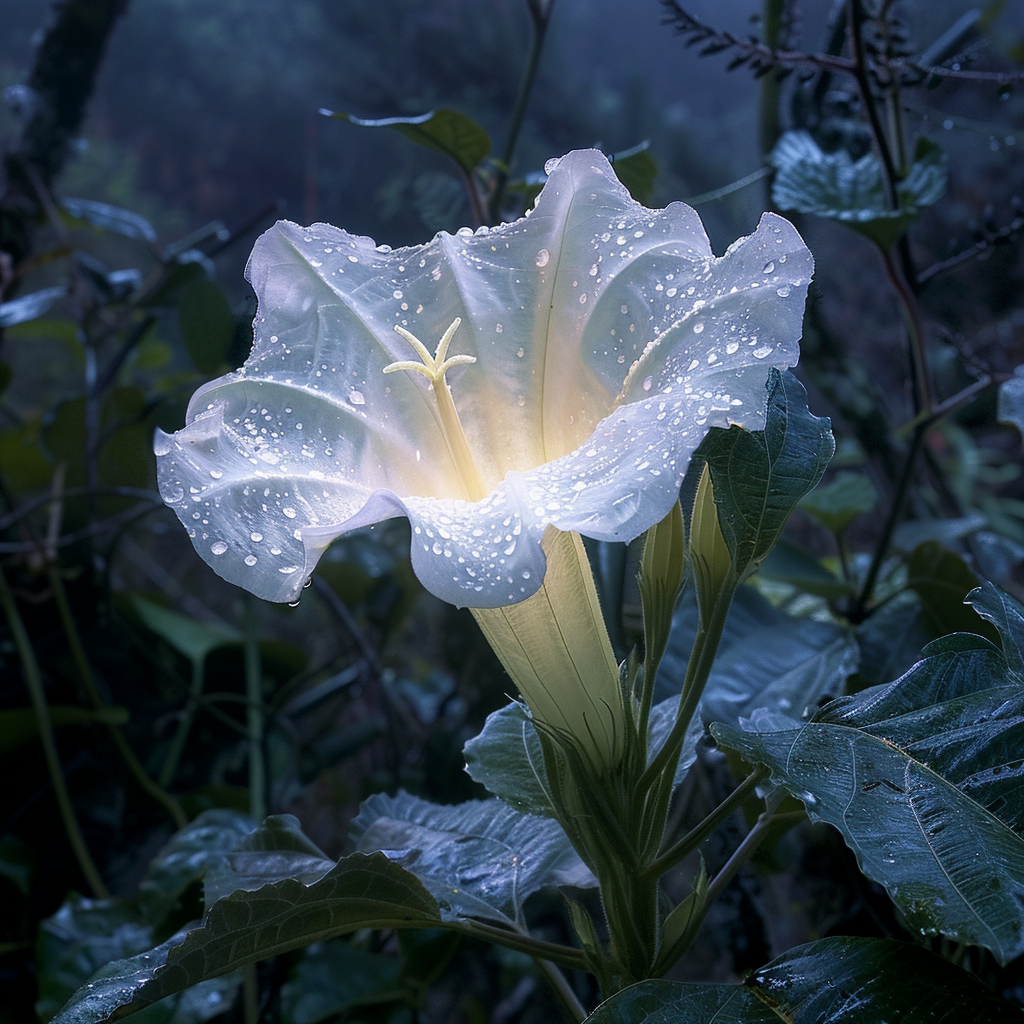
Toe
Brugmansia, also known as Toé, stands as an herbaceous perennial plant flourishing in temperate and tropical regions worldwide. Renowned for its poisonous nature, some species are esteemed for their aphrodisiac properties, yet caution is warranted due to their toxicity akin to deadly nightshade and henbane. Despite its perilous reputation, Brugmansia boasts a rich history in Ayurvedic medicine, spiritual practices, and modern pharmaceuticals.
Sacred Healing in South America
In South America, Brugmansia assumes a revered role in treating specific ailments, reserved for cases where conventional remedies prove futile. Shamans wield this potent plant with utmost caution, as its formidable potency necessitates meticulous preparation of the patient’s system. Often considered one of the five master plants in the Amazonian tradition, Toé serves as a profound initiation tool for apprentices, guiding them through transformative spiritual journeys.
Exploring the Depths of Light and Shadow
Embodying both light and dark energies, Brugmansia offers a profound avenue for delving into our inner shadows and facilitating healing on multidimensional levels. Its adeptness at masking itself as dark energy enables it to navigate and transmute darkness into light, while boasting potent anti-cancer properties and facilitating the healing of severe pains and traumatic injuries. Moreover, Brugmansia holds the power to revitalize the nervous system and restore function to paralyzed body parts.
Traversing the Spirit Realm
Under the influence of Brugmansia, individuals traverse the spirit realm in a somnambulistic state, their consciousness oscillating between the material and spiritual planes. Encountering visions of ethereal landscapes, they embark on mystical journeys through dark forests illuminated by the eternal sun of the spirit world. Led by the enigmatic Mother of Toé and other spirit beings, patients seek healing in invisible Saankariite villages, where shamans and healers dispel intrusive energies and reveal the root causes of illness.
Navigating the Labyrinth of Spiritual Trials
While the Saankariite and Mother of Toé wield formidable healing powers, their mischievous nature demands vigilance from the patient. These ethereal beings offer profound insights and cosmic revelations, yet may also engage in playful trickery or present deadly challenges. In return for their aid, they may request concessions or tempt individuals with perilous sorcery teachings. However, as the effects of Brugmansia wane, memories of the spirit world fade into the realm of vague dreams, leaving behind a profound sense of mystery and transformation.

Ayahuma
Couroupita guianensis, towering in stature, emanates a formidable energy that surpasses smaller plant medicines. Yet, there is no cause for trepidation, as this spirit embodies gentleness and compassion, serving as a benevolent guide capable of bestowing profound protective energies. Across diverse tribal traditions, shamanic healers unite in their reverence for the Ayahuma tree’s primary purpose: to impart protective qualities for forthcoming ceremonies.
Revealing the Essence of Ayahuma
Ayahuma’s fruits, bearing resemblance to cannonballs, lend the tree its English moniker. Flourishing in the tropical realms of Central and South America, these majestic trees soar to heights exceeding 55 meters. Though the fruits remain inedible, they harbor potent antimicrobial and antibacterial properties, often harnessed to heal wounds, treat common skin conditions, and combat topical fungal ailments. Notably, the large oblong petals of Ayahuma’s leaves offer relief from toothaches when chewed.
Brewing Nature’s Remedy
The amalgamation of Ayahuma’s fruit and bark yields a formidable anti-inflammatory elixir, revered for its wound-disinfecting prowess. Boasting antibacterial and antifungal attributes, this concoction serves as a potent remedy for colds and stomach upsets. Additionally, the tree’s woody berries, initially yellow and later dried into a powder, combat hair loss with their nourishing properties.
Navigating the Dieta Process
During the master plant dieta, Couroupita guianensis takes center stage, often heralded by visions of resplendent flowers, evoking a profound sense of unity with nature. Purging may occur during the dieta, accompanied by an expansive, vibrational sensation within the stomach. As doses are meticulously prepared and consumed under the guidance of a curandero, the dietero commits to a special diet and lifestyle, fostering a profound relationship with the plant spirit.
Spiritual Significance:
Ayahuma, a grounding master plant, beckons the dietero to embark on a transformative odyssey, shedding past traumas and stored emotions to embrace resilience and wisdom. The Quechua-derived name, signifying “dead head,” pays homage to the distinctive shape of Ayahuma’s fruits. Infused with warming and protective energies, Ayahuma fosters vulnerability, catalyzing profound releases and infusing the dietero with compassion. Through deepened perceptions, an intimate connection with all life on Earth is forged, epitomizing the tree’s greatest gift.

Chuchuhuasi
Scientifically classified as Maytenus laevis, Chuchuhuasi is a majestic tree that graces the Amazon rainforest with its towering presence and abundant foliage. Its sturdy trunk and lush green leaves symbolize resilience and vitality, reflecting the rich biodiversity of the rainforest ecosystem. Chuchuhuasi has been revered for centuries by indigenous communities for its potent medicinal properties and spiritual significance.
Alleviating Arthritis and Rheumatism
Chuchuhuasi, esteemed for its enduring effectiveness, occupies a significant role in herbal remedies, particularly renowned for easing the discomfort of arthritis and rheumatism-related symptoms. Within the realm of Peruvian herbal medicine, extracts of Chuchuhuasi bark, often in alcohol form, are administered to alleviate both osteoarthritis and rheumatoid arthritis.
Abundant in alkaloids, tannins, triterpenes, and sesquiterpenes, the bark boasts remarkable anti-arthritic properties, primarily attributed to its pyridine alkaloids. Research conducted by “Sphinx Pharmaceuticals” in Durham, North Carolina, highlights the presence of agents in Chuchuhuasi bark that inhibit protein kinase C (PKC), an enzyme implicated in various degenerative and inflammatory diseases. This inhibitory action is believed to significantly enhance Chuchuhuasi’s efficacy in addressing arthritis.
Furthermore, the potent anti-inflammatory attributes of Chuchuhuasi were affirmed through chemical analysis in 1982, corroborating its therapeutic potential as revered in traditional medicine.
In essence, the synergistic interplay of PKC inhibition, alongside Chuchuhuasi’s anti-inflammatory and muscle-relaxing characteristics, positions it as a potent natural remedy for arthritis and inflammatory conditions.
Boosting Immunity
Dubbed the “Brazilian Ginseng,” Chuchuhuasi is classified as an adaptogen—a class of herbs revered for their ability to restore and fortify the body against external stressors. Its adaptogenic nature enables it to function as an “immunomodulator,” adept at regulating the immune system’s responses to external stimuli. By revitalizing overburdened adrenal glands, Chuchuhuasi serves as a shield against the breakdown of bodily systems triggered by adrenal fatigue.
Aphrodisiac Qualities
Chuchuhuasi’s vasodilatory properties facilitate enhanced blood flow to the pelvic region and reproductive organs, earning it acclaim as a potent aphrodisiac. Traditionally, communities in the Amazon consume Chuchuhuasi tonic to bolster stamina, sexual function, and libido. Although the specific compounds responsible for its aphrodisiac effects remain elusive, the alkaloids present in the plant are believed to stimulate libido recovery and sexual function. This, coupled with improved blood circulation to the sexual organs, explains its popularity among middle-aged men seeking to enhance virility, prolong erections, and alleviate impotence.
Managing Menstrual Disorders
Chuchuhuasi’s adaptogenic traits extend to female hormonal systems, enabling it to balance, fortify, and regulate them effectively. As an emmenagogue, it fosters menstrual regularity and provides relief from menstrual pains and cramps owing to its muscle-relaxing properties.
Spiritual Significance and Shamanic Practices
Revered as “Chucuhuasi Tree Medicine,” this sacred plant serves as a spiritual guide in shamanic practices. Shamans incorporate it into shamanic diets or as an adjunct to Ayahuasca ceremonies, leveraging its therapeutic and spiritual attributes. Regular consumption of Chuchuhuasi aids individuals in navigating the challenges associated with prolonged Ayahuasca use and the accompanying dietary restrictions, thereby facilitating accelerated personal development. As a potent tonic, it imparts strength and fosters a sense of justice in one’s life, restoring the father structure to its rightful place.
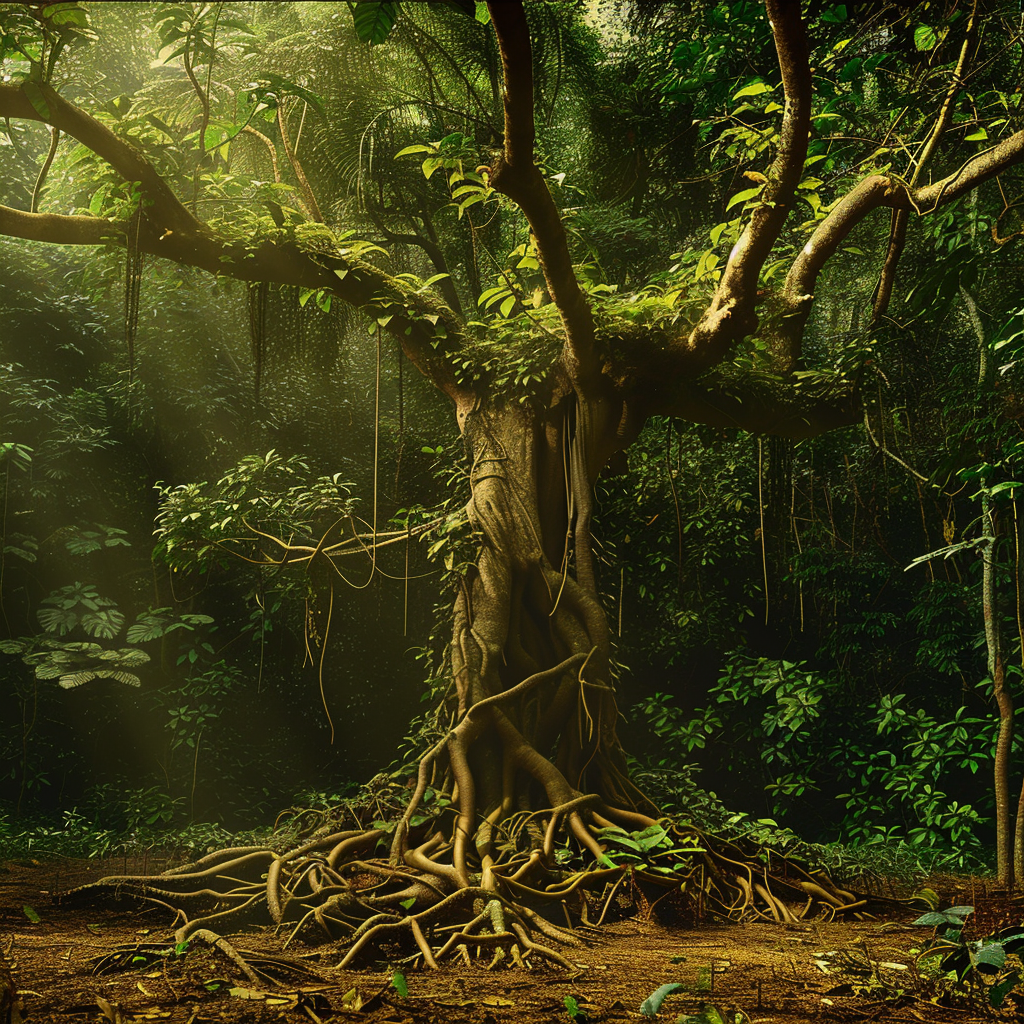
Renaquilla
Often mistaken for a tree, Renaquilla emerges as a sprawling vine-like plant that intertwines with its host tree, symbolizing a profound union and inseparability. Just as Renaquilla binds itself to its host, its healing properties work to unite and strengthen fractured aspects across the physical, emotional, and spiritual realms of existence.
Neural Reprogramming: Expanding Consciousness
Renaquilla possesses a unique ability to reprogram the neural network, infusing the system with enhanced cellular health and triggering an expansion of consciousness. This transformative process heightens intuitive awareness, particularly in energy workers focusing on bone and connective tissue-related issues, offering profound insights into the interconnectedness of mind, body, and spirit.
Skeletal Healing: A Journey of Alignment
Embarking on a dieta with Renaquilla entails a deep dive into the realm of skeletal healing, where the plant’s essence works intricately with the bones and back, facilitating the realignment and rejuvenation of the muscular and skeletal systems. Extracts from Renaquilla’s bark serve as potent remedies for fractures, contusions, hernias, and inflammation, offering relief and restoration to the physical body.
Physical Rejuvenation: Harnessing the Power of Unity
Renaquilla’s physical benefits span a broad spectrum, ranging from relief against rheumatism and arthritis to the rejuvenation of reproductive systems. This feminine plant cleanses and stabilizes the heart, harmonizes digestive issues, and detoxifies the blood, promoting overall well-being and vitality. Its regenerative properties extend to bone health, aiding in the healing of fractures and dislocations while releasing stagnant energy and restoring balance.
Physical Benefits:
- Relieves or protects against rheumatism
- Relieves arthritis
- Heals trauma held in the body
- Harmonizes digestive issues
- Cleanses & stabilizes the heart
- Water retention
- Bone regenerator for open fractures
- Heals dislocations
- Heals internal and external wounds
- Releases corporal cold energy
- Releases weak or heavy corporal energy
- Uterine disorders
- Stimulates circulatory system
- Heals reproductive system
- Hernias
- Bruises
- Detoxifies & purifies blood
- Regulates circulatory system
- Helps with Spleen
- Prevent uterus prolapse
- Heals yeast Infections
- Relieves stomach pains
- Cures frights
- Regulates the entire female reproductive system
- Rejuvenates the root systems running through the body
- Strengthens women
- Increases energy
- Reprograms cells
Spiritual Significance:
Embodying the essence of unity and forgiveness, Renaquilla guides individuals on a journey of emotional and spiritual healing. Through its powerful teachings, it fosters reconciliation in fractured relationships, promotes forgiveness, and reconnects individuals with the natural world. Heightened awareness and intuition accompany this spiritual journey, leading to profound insights and a deeper sense of connection to oneself and the universe.

Noya Rao
This towering tree stands as a symbol of spiritual enlightenment and physical well-being. Flourishing in the diverse ecosystems of the Amazon basin, Noya Rao beckons seekers with its towering stature and vibrant greenery, embodying the ancient wisdom interwoven within the rainforest. Its introduction to healing practices represents a bridge to the rich botanical tapestry of the Amazon, offering a holistic approach to both spiritual and physical rejuvenation.
The Sacred Tree of Light
Noya Rao, also known as “Palo Volador” or “The Flying Tree,” stands as a mythical plant shrouded in mystery, with only five known specimens in the vast expanse of the Amazon Basin. Renowned for her luminous leaves that glow in the darkness, she is aptly named “The Tree of Light” by seekers who are drawn to her ethereal presence. In the rich tapestry of Shipibo culture, “Noya” translates to “Flying,” while “Rao” signifies “Plant Spirit,” endowing her with the cherished moniker of “The Flying Plant Spirit.” Embraced by the Mahua Shipibo traditions for centuries, the bark of Noya Rao is revered as an essential component in the journey toward becoming a healer.
Embodiment of Divine Light
Within the sacred framework of Shipibo tradition, plants are believed to possess spirits, embodying both light and darkness. Yet, Noya Rao transcends this duality, radiating pure goodness, light, and love—a manifestation of the divine feminine. She stands as a beacon of enlightenment, akin to Buddha or Christ, symbolizing the potential for transcendence inherent in all beings. Through her gentle guidance, Noya Rao empowers seekers to discover their life purpose and highest path, facilitating humanity’s evolution toward greater consciousness and unity.
Adhering to the Dieta: A Sacred Covenant
As a master plant, Noya Rao demands reverence and commitment from those who seek her healing embrace. Completing a dieta with her requires strict adherence to prescribed dietary and behavioral guidelines, guided by the wisdom of experienced curanderos and the plant spirit herself. This sacred pact, rooted in respect and devotion, paves the way for profound spiritual communion and transformative healing.
Spiritual Significance:
Dieting on the bark of Noya Rao initiates a profound journey of spiritual transformation, enhancing one’s connection to other sacred plant spirits and catalyzing personal growth. This sacred regimen fosters mental clarity, organized thought, and intuitive insight, illuminating unconscious beliefs and perceptions that may limit one’s potential. By courageously embracing change and releasing outdated paradigms, seekers emerge from the dieta with newfound wisdom and spiritual resilience.
Master Plant Dieta
A master plant dieta, sometimes referred to as a shamanic dieta, is an agreement lasting typically 7 to 30 days between an individual and a (usually non psychotropic) Amazonian plant, conducted under the guidance of Maestra Matilde and supported with the Ayahuasca ceremonies. It is a profound and immersive process aimed at developing a deeper connection with plant spirits and gaining spiritual insights and healing.
It is important not to confuse master plant dieta with ayahusca preparation diet: the first one refers to the mental and physical regime that is held during a retreat, while the second one is about how a participant should prepare him/herself before the retreat.
Process of Master Plant Dieta:
1. Intention and Preparation: The process begins with setting a clear intention for the dieta. This intention typically involves seeking guidance, healing, spiritual growth, or learning from the plant spirits. A prospective dieter will often seek the guidance of a Shipibo master or healer to determine which plant to work with.
2. Plant Selection: The master or healer will guide the individual in selecting a specific plant or tree for the dieta. Each plant possesses unique energy, qualities, and teachings. The chosen plant will be the focus of the dieta, and its spirit will be the main guide throughout the process.
3. Isolation: Dieters enter a period of isolation and seclusion from the community and everyday distractions. They reside in a designated dieta hut or maloca—a small retreat space—away from human interactions. This isolation allows for focus, introspection, and establishing a direct connection with the plant spirit.
4. Dietary Restrictions: During the dieta, participants adhere to a strict and specific diet as prescribed by the master or healer. This diet typically excludes salt, sugar, oil, spices, alcohol, caffeine, and certain types of meat. The purpose is to purify the body and enhance sensitivity to the plant spirit.
5. Plant Medicine Consumption: Throughout the dieta, the participant consumes the plant medicine in various forms, such as decoctions, infusions, or in some cases, during ayahuasca ceremonies. The frequency and dosage depend on the guidance of the healer. Plant medicine facilitates communication, healing, and the transmission of knowledge from the plant spirit.
6. Meditation, Contemplation, and Visionary Work: The dieter engages in profound introspection, meditation, and contemplation. This may involve practices like dieta-specific icaros (sacred songs) and dieta-related rituals. Participants may also experience visionary states induced by the plant medicine, providing profound insights and healing
7. Integration: After the dieta period ends, integration is crucial. The dieter gradually reintegrates into the community and normal life while maintaining the post-dieta dietary restrictions and engaging in specific practices to deepen the connection with the plant spirit. Integration may involve reflecting on the experiences, implementing the teachings in daily life, and honoring the spirit of the plant through ongoing rituals or ceremonies. It is important to note that the Shipibo master plant dieta is a deeply personal and individual experience that varies based on the guidance of the master, the chosen plant spirit, and the dieter’s unique journey. It is a method of spiritual exploration, self-discovery, healing, and communion with the natural world.
Inca Shipiba, in collaboration with an integration counselor, offers post-dieta sessions aimed at supporting participants in their journey of self-discovery and healing. These sessions provide a safe space for individuals to reflect on their dieta experience, explore insights gained, and address any challenges or emotions that may arise during the integration process. Through guided discussions and personalized guidance, participants can deepen their understanding of themselves and integrate the lessons learned from the dieta into their daily lives. Sessions can be scheduled at the convenience of the participant to ensure ongoing support and guidance on their healing journey.Learn more here
Typical master plant dieta retreat schedule:
DAY 1 – Arrival
Arrival, meeting Maestra Matilde’s family and staff, setting into your hut, logistic and schedule explanation, lunch, relax time with meditation and journaling, dinnerDAY 2 – First Ceremony
Breakfast, introduction to the retreat and preparation for the ceremony, lunch, flower bath at 5pm, meeting in the Maloca at 7pm for the ceremony. After the ceremony is over, you can sleep on your bed in the Maloca.DAY 3 – Integration day
Breakfast, Lunch, Dinner, journaling, taking time for grounding and solidifying the experience avoiding social contact as much as possible, singing, meditating, journaling.DAY 4 – Second Ceremony
Breakfast, sharing circle where everyone will get the chance to safely talk about their experience, lunch, integration time, plants bath at 5pm, meeting in the Maloca at 7pm for the ceremony.DAY 5 – Integration day
Breakfast, Lunch, Dinner, journaling, taking time for grounding and solidifying the experience avoiding social contact as much as possible, singing, meditating, journaling.DAY 6 – Third Ceremony
Breakfast, sharing circle, lunch, integration time, plants bath at 5pm, meeting in the Maloca at 7pm for the ceremony.DAY 7 – Closing
Breakfast, closing sharing circle, lunch, you can also stay here for dinner if you like.

